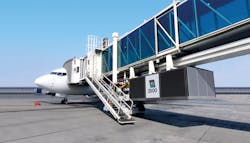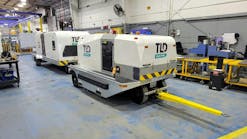ITW GSE: 2023 Product Leader of the Year
The commercial aviation industry is pushing for greener, more environmentally friendly operations. These initiatives are impacting the way ground support equipment (GSE) is being designed as well as how it is being utilized on the ramp.
This push for greener GSE includes pre-conditioned air (PCA) units and ground power units (GPUs), which eliminate the need for using auxiliary power units (APUs) on aircraft.
“With the industry moving towards sustainable GSE solutions imposed by governments and local authorities, there is a need for equipment with lower energy consumption to support this,” says Alberto Rocha, sales director for the Americas at ITW GSE. “The increasing focus on environmental issues is a great incentive to switch to external PCA and 400 Hz solid-state units while the aircraft is parked at the gate, instead of running the aircraft APU.”
To assist the industry in meeting environmental goals, ITW GSE launched its 3500 PCA in November 2022. Improving upon its 3400 model, the new unit offers automated aircraft detection to improve airflow utilization, a modular design to enhance ease of use and optional Intelligent Power Management to further increase power consumption efficiencies.
With features designed to reduce infrastructure costs and lower energy consumption, ITW GSE has been named the 2023 Ground Support Worldwide Product Leader of the Year.
Automatic Airflow Detection
A key feature of ITW GSE’s 3500 PCA is its patented Variable Frequency Drive (VFD) technology, which enables stepless regulation of discharge temperatures. With this technology, the PCA unit delivers the exact amount of cooled air required.
“VFD also means energy savings because the VFD controls all main components, including compressors, fans and blowers,” Rocha explains, adding this ensures a minimum total lifetime cost. “In addition to energy savings, state-of-the-art components ensure high performance at the output.”
The 3500 PCA includes an integration to Visual Docking and Guiding Systems (VDGS), the airport’s Building Management System (BMS) and other data collecting systems. Engineers at ITW GSE have created an algorithm that factors in different aircraft types and their needs for air, including airflow, pressure and temperature.
“This automated aircraft type detection feature means that the PCA receives information on the arriving aircraft type as soon as the aircraft approaches the gate. From its aircraft database, the PCA already knows the exact aircraft settings,” Rocha says. “Automated aircraft type detection makes the 3500 the only PCA on the market to automatically adapt its airflow to the specific aircraft type – and not just to an aircraft category. This not only helps to avoid operator errors – it also increases the PCA cooling performance by more than 50 percent and improves the passenger comfort.”
Rocha notes the system offers simplified operation, adding the PCA’s operator only needs to use the on and off function. More importantly, Rocha notes the equipment automatically calibrates itself to deliver the exact airflow and temperature required to maintain a comfortable aircraft temperature for passengers.
Modular Design
ITW GSE’s 3500 PCA has improved on the modular design of its 3400 PCA model.
By utilizing this design, cooling and optional heater modules can be quickly swapped out, which helps keep aircraft turnarounds on schedule.
According to Rocha, the modular design also assists with spare part inventories.
When components need to be replaced, all parts, such as the self-containing cooling modules, condenser fans and main blower, can be replaced without removing the PCA unit from the passenger boarding bridge, he says. The modular design also enables quick cleaning. Once the cooling modules have been pulled out, the internal plenum and stainless steel drain pan are accessible.
In the event a module is not working, the PCA does not shut down entirely. Rather, explains Rocha, the unit’s software will identify the non-operating module and spread the cooling demand to the other modules.
“When you have a system that has multiple modules, you can actually take one out and continue to operate with what's remaining in the system while you repair the other one,” Rocha says, adding customer feedback on this feature has been very positive.
As an option, the 3500 can also utilize a built-in 400 Hz GPU. Integrating the GPU with the PCA means saving space and reducing the weight under the passenger boarding bridge, Rocha explains.
“Consequently, instead of having two boxes that communicate and share power, the ITW GSE 3500 is a single enclosure that controls the complete system, which makes it easier to install and consequently lowers infrastructure costs,” he says. “This makes it the ideal solution for narrow-body contact gates and refurbished gates.”
IPM and EcoGate
The company’s Intelligent Power Management (IPM) solution is available as an option for the 3500 PCA.
“The 3500 works perfectly well as a PCA without IPM. But in order to exploit the full, intelligent potential of the 3500, you need IPM,” Rocha says. “IPM is the brains behind the EcoGate system and it’s hosted in the ITW GSE 3500 PCA. With IPM, all ITW GSE equipment can be powered from a single power line running from the gate’s power supply to the 3500 PCA.
“From there, IPM allocates power dynamically to the different units – always prioritizing the needs of GPUs, while ensuring that total power capacity is not exceeded.”
With IPM capabilities, the PCA is able to monitor all connected equipment. It adjusts the PCA’s power consumption to stay below the preset current limit of the complete gate system, which ensures that all on-ground electrical needs can be supplied by the connected GPU.
“This means that the aircraft is serviced, and the combined power consumption of the PCA and GPU never exceeds the installed power capacity at the gate,” Rocha says.
Additional EcoGate-compatible equipment, such as a PCA hose retriever or eGSE charger, can also utilize the IPM.
“It is a whole new environment with this technology, where before they had to run individual feeds for each product, now it's just feed one and then that one controls the whole power consumption for the other accessories,” Rocha says.
Units in Demand
According to ITW GSE, the 3500 PCA is already in great demand globally from airlines, airports and passenger boarding bridge manufacturers. Rocha credits this demand to the unit’s modular design, which allows ITW to scale PCAs to accommodate any climate and any commercial aircraft.
The 3500 is produced at ITW GSE facilities in Palmetto, Florida, in the United States and Odense, Denmark.
“The demand for PCAs is really taking off especially in the Americas, and the first PCA 3500s will be supplied as of summer 2023,” Rocha says, noting units will be delivered to Harry Reid International Airport (LAS) in Las Vegas, Detroit Metropolitan Wayne County Airport (DTW) and San Diego International Airport (SAN).
“The 3500 is a demonstration of our commitment to supplying the aviation industry with the cleanest, most reliable and cost-effective GSE systems available,” Rocha concludes.









